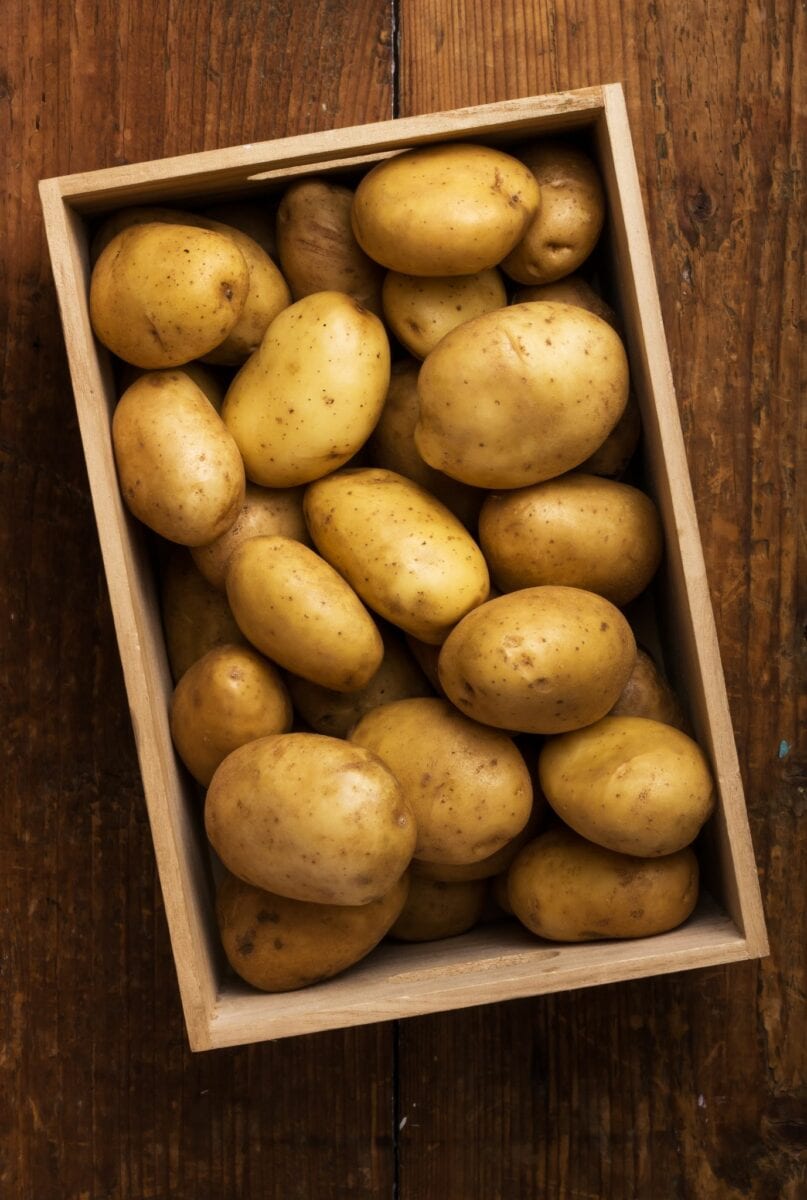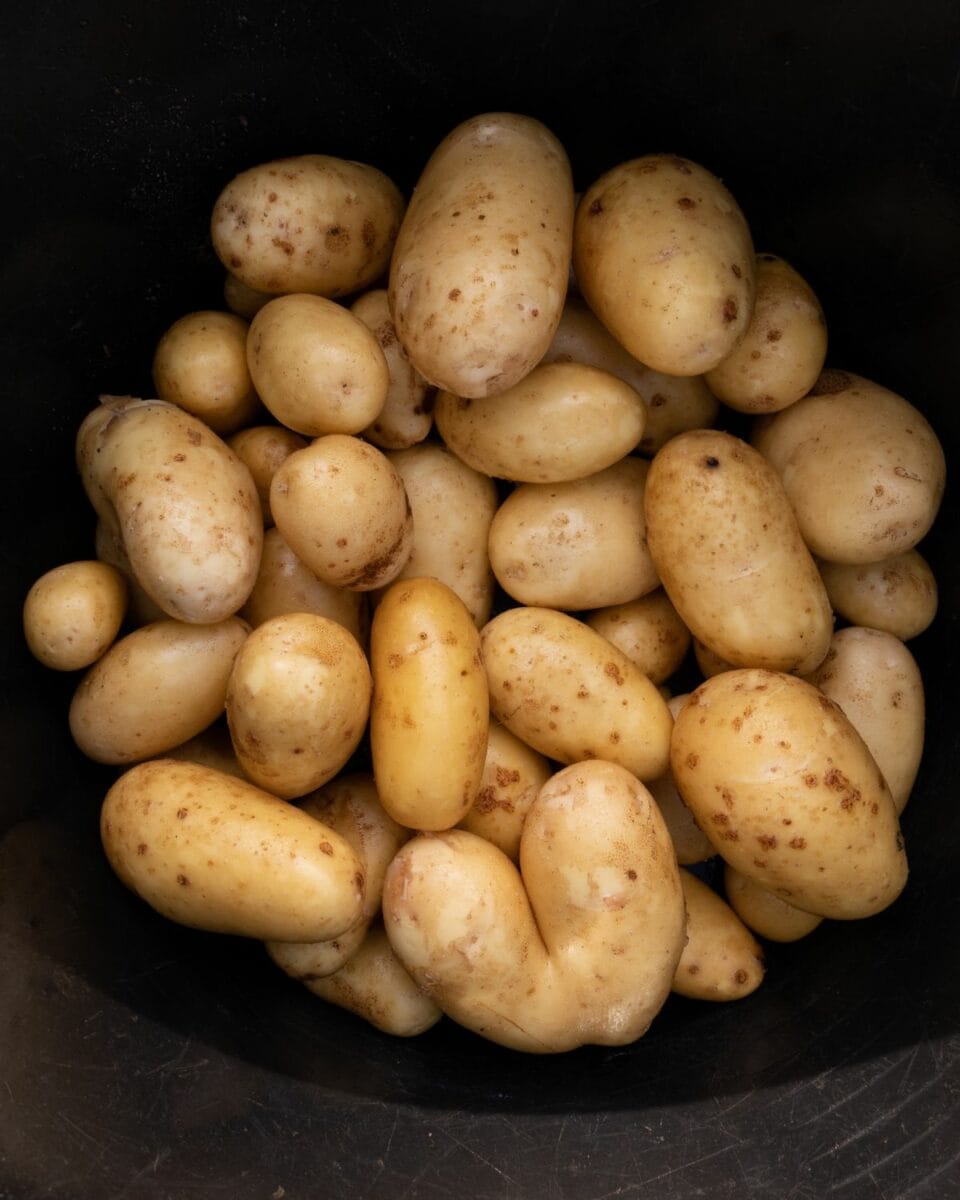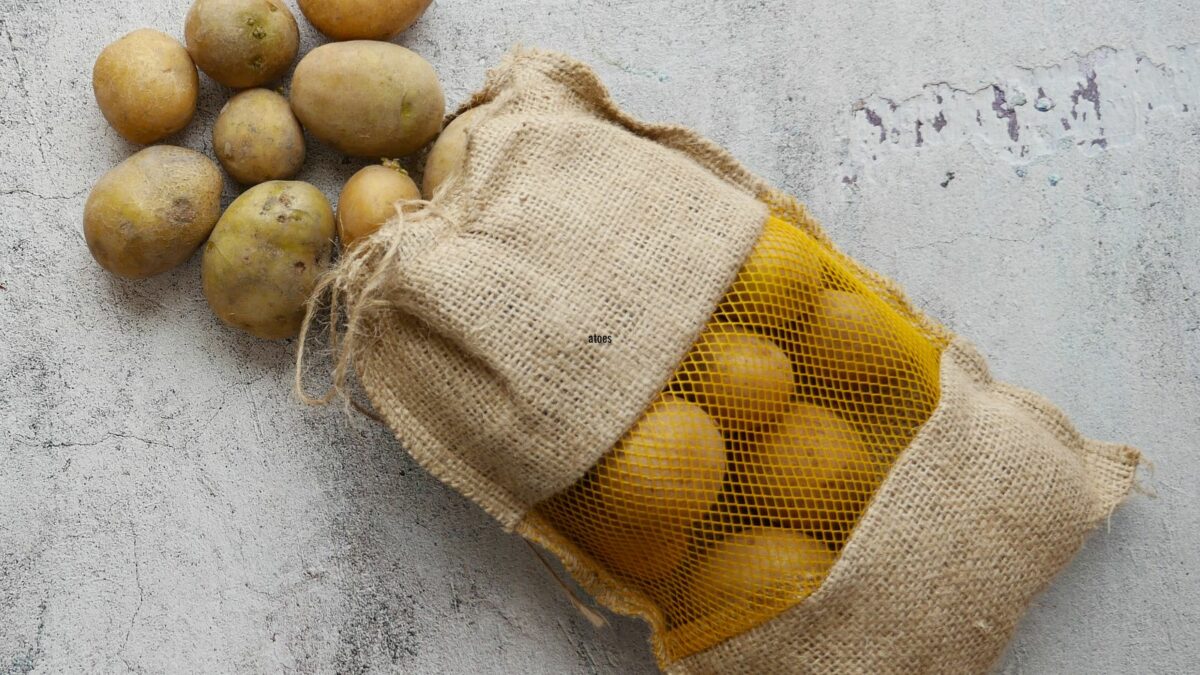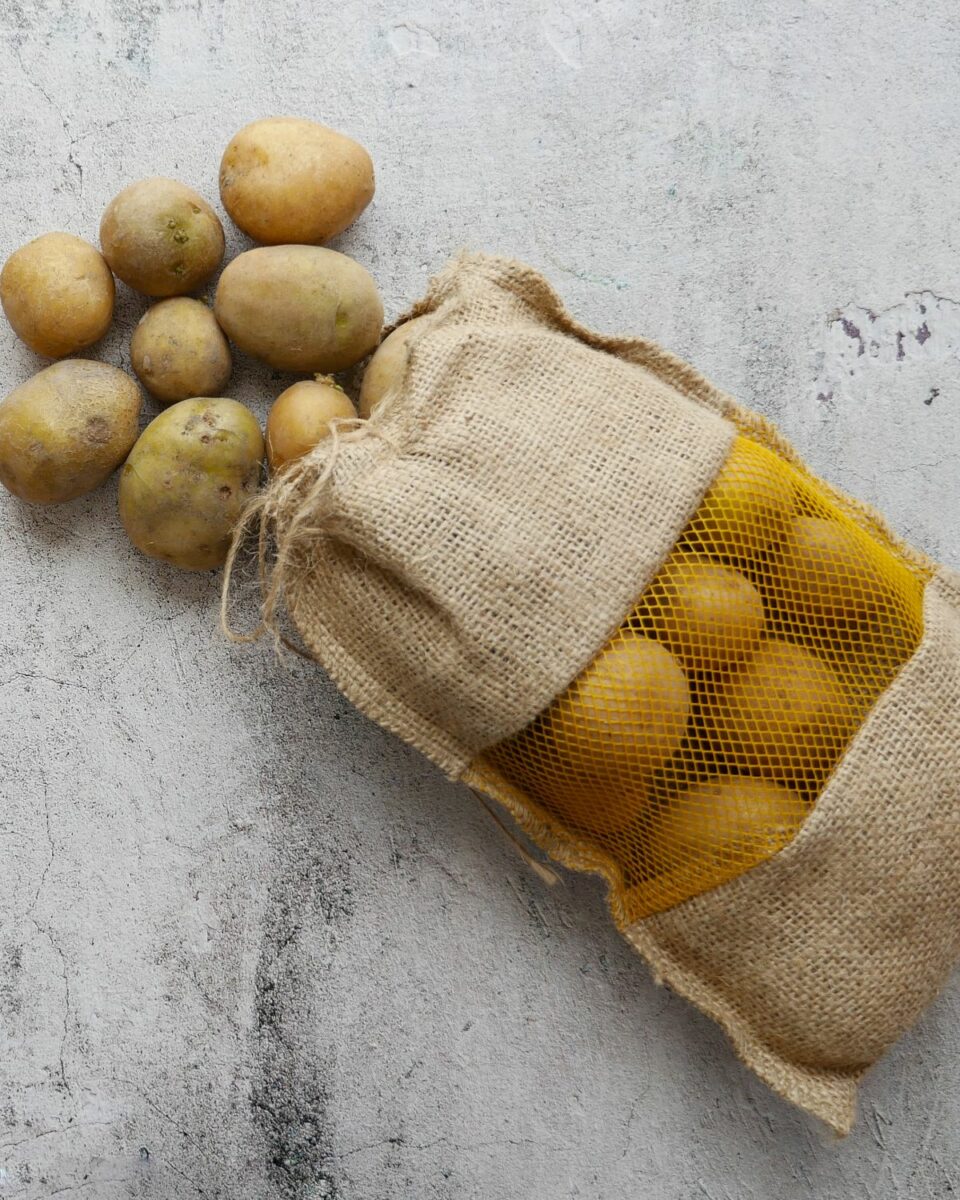Ever rummage through your pantry only to find a sad, wrinkled potato staring back? We’ve all been there. But learning how to store potatoes isn’t just about keeping them from turning into sad little spuds (although that’s a definite bonus). It’s about unlocking weeks, even months, of delicious possibilities.
Proper storage keeps potatoes fresh and ready to turn into your favorite fries or mashed masterpieces. So skip the last-minute grocery store runs and the green sprout surprises. Learn how to store potatoes and ensure you always have this versatile veggie on hand when you need it.
🗝️Key Takeaways
- Maximize Potato Freshness: Proper storage can keep potatoes fresh for 3-5 weeks in the pantry and up to 4 months in a cool, dark place, crucial for budget meal planning.
- Ideal Storage Conditions: Balancing humidity, cool temperatures, good airflow, and darkness while keeping potatoes away from ethylene-producing produce like onions ensures longevity and maintains texture and flavor.
- Storage Methods: Options include perforated plastic bags, root cellars, baskets, paper or mesh bags, and boxes in cool, dark locations.
- Regular Checks and Organization: Inspect potatoes weekly for sprouting, softness, or decay, removing affected ones. Use a first-in, first-out system for long-term storage to prevent waste.
📆How long can potatoes last?
When stored properly, uncooked potatoes can last anywhere from three to five weeks in the pantry and three to four months in a cool, dark place. This makes them an ideal vegetable to buy in bulk for meal planning on a budget.
☀️Creating the ideal environment
To store potatoes, you must balance humidity, temperature, airflow and light exposure. You must also ensure the potatoes are not too near other produce.
Humidity levels
Potatoes prefer a high-humidity environment, ideally between 80% to 90%. To achieve this, you can store them in perforated plastic bags or a root cellar where natural humidity is often higher.
Temperature
Store your potatoes at a cool temperature, ranging from 45 F to 50 F. But don’t store them in the refrigerator since lower temperatures can convert the starch in potatoes to sugar, which changes their taste and cooking properties.
Airflow
Good ventilation is crucial since excess moisture can lead to spoilage. Ensure your storage area allows air to circulate around the potatoes, such as slatted crates, perforated bags or baskets.
Light exposure
Potatoes should be kept in the dark since light can cause them to turn green and produce a toxin called solanine. Use paper bags, burlap or a closed box to shield them from light or store them inside a closed cabinet. Check periodically to remove any potatoes that have started to turn green.
Keep potatoes separate
Potatoes should be stored away from other produce that can accelerate spoilage. Many fruits and vegetables emit ethylene gas as they ripen, which can cause potatoes to start sprouting.
Some of the most common ethylene gas troublemakers are onions, apples, bananas and tomatoes. Instead, store potatoes near other root vegetables, like sweet potatoes, that have similar storage needs.
“Keep potatoes away from your onions. Potatoes and onions do not get along. The gases that onions exude cause potatoes to sprout faster, so they will go bad more quickly than you’d like.”
— Michelle Price, Honest and Truly

⭐Don’t Miss These Delicious Air Fryer Potato Recipes
- Air Fryer Smash Potatoes: Crispy on the outside and tender on the inside, these smash potatoes are a quick and delicious side dish made effortlessly in the air fryer.
- Air Fryer Hasselback Potatoes: Thinly sliced and seasoned for maximum flavor, Hasselback potatoes come out perfectly crispy in the air fryer.
- Air Fryer Baked Potatoes: Achieve fluffy, tender interiors and crispy skins with these perfectly cooked baked potatoes from the air fryer.
- Air Fryer Fingerling Potatoes: These air-fried fingerling potatoes offer a crispy skin and soft interior, seasoned to perfection for a simple yet satisfying side.
- Air Fryer Baby Potatoes: Baby potatoes become irresistibly crispy and tender in the air fryer, making for a quick, versatile side dish.
- Air Fryer Twice Baked Potatoes: Featuring a creamy and cheesy filling, these twice-baked potatoes are finished to perfection in the air fryer.
❓How to store potatoes at home
The right storage can significantly extend the shelf life of your potatoes. Here are some of the most common choices, along with advantages and disadvantages. Choose a method that best fits your needs and space.
- In a bowl: Place your potatoes in a dry, well-ventilated bowl. Keep the bowl dark so the potatoes are not exposed to sunlight.
- In a basket: A basket allows for good airflow, which prevents moisture build-up and spoilage. Keep it in a cool, dark and dry area of your home.
- In the original packaging: If your potatoes came in a perforated plastic bag, you can keep them in their original packaging to balance humidity and avoid sprouting.
- In a paper bag: A paper bag is ideal for maintaining dry conditions. Fold the top of the bag over to protect the potatoes from light.
- In a mesh bag: A mesh bag is a great alternative that provides excellent ventilation.
- In a box: A cardboard box can be suitable if kept in a cool and dark place, such as a basement. Ensure the box is open or has holes for adequate air circulation.
- In the refrigerator: Storing potatoes in the refrigerator is not recommended, as cold temperatures can turn the starch into sugar and alter the taste. If you must refrigerate, use them quickly.
🔎Check your potatoes
When storing potatoes, it’s not just enough to create a good environment. Regular inspection and proper separation are necessary, too.
Check your potatoes regularly to make sure they are in good condition. Remove any potatoes that are sprouting, soft or showing signs of decay so these issues don’t spread to the rest. Check your potatoes about once a week for the best results.
🥔How to store potatoes for longer times
A first-in, first-out approach is essential when storing potatoes for long periods. So, organize your potatoes in a way that allows you to access the oldest ones first easily. If you are holding many potatoes, label them with the storage date.
“After harvesting 80 to 100 pounds of potatoes each season, we store them in banana boxes on shelves in a cold, dark section of our garage. It’s important to dig up the potatoes while the soil is dry so that they can be put away dry. They should not be washed before storing. They will last eight to 10 months here before they start going to seed.”
— Dan Morris, Fire and Saw

🛠️Troubleshooting common issues
The most common potato issues are sprouting, shriveling and discoloration. Promptly addressing these issues can help maintain the quality of your potatoes.
- Sprouting occurs when potatoes are exposed to light. If sprouts develop, remove them and use the potatoes promptly.
- Shriveling happens due to moisture loss. Keep your potatoes plump in a high-humidity environment and avoid direct sunlight. If your potatoes begin to shrivel, consider using them in recipes that require less visual appeal but are flavor-focused, like mashed potatoes.
- Potato discoloration can occur due to exposure to light or temperature changes. To keep potatoes from changing color, keep them stored at a constant temperature and away from light. If discoloration is slight and the potatoes are firm, they are still usable. However, you should throw away potatoes if the discoloration is accompanied by a rotten smell or a mushy texture.
⭐Don’t Miss These Potato Recipes
- Cheesy Grilled Potatoes: Perfectly grilled until crispy and smothered in melted cheese, these potatoes are an irresistible side dish for any barbecue.
- Garlic Mashed Potatoes: Creamy and rich, these mashed potatoes are infused with the robust flavor of garlic, making them a comforting and flavorful side.
- Salt Potatoes: Boiled in heavily salted water, these tender potatoes have a unique, creamy texture and a salty crust, a simple yet delicious treat.
- Fiesta Potatoes: Bursting with spices and colorful vegetables, Fiesta potatoes are a bold and zesty side dish that brings a party to your plate.
- Breakfast Potatoes: Crispy on the outside and soft on the inside, these seasoned potatoes are the perfect savory start to any morning.
✔️Selecting the right potatoes
Selecting high-quality potatoes ensures they will last longer. Pay attention to the potato variety and freshness when you buy them. When picking potatoes, these are the most important factors to consider.
- Skin Integrity: Choose potatoes with firm, unblemished skins. Avoid those with cuts or soft spots.
- Eye Count: Buy potatoes with fewer eyes. Numerous or sprouted eyes indicate old potatoes.
- Firmness: They should be firm to the touch. Soft, yielding potatoes are past their prime.

📚Summing up
You can avoid sprouting, shrinking or rotting potatoes by understanding how to store potatoes. Maintaining the proper humidity, temperature, airflow and darkness is crucial. Ensure your potatoes are stored separately from ethylene gas-emitting fruits and vegetables.
Whether you choose a basket, mesh bag or cardboard box, select a method that suits your space and needs. With proper storage, you can confidently enjoy your potatoes for weeks or even months so that you can create delicious potato dishes, from twice baked potatoes to roasted potatoes.
This article originally appeared on Food Drink Life.



